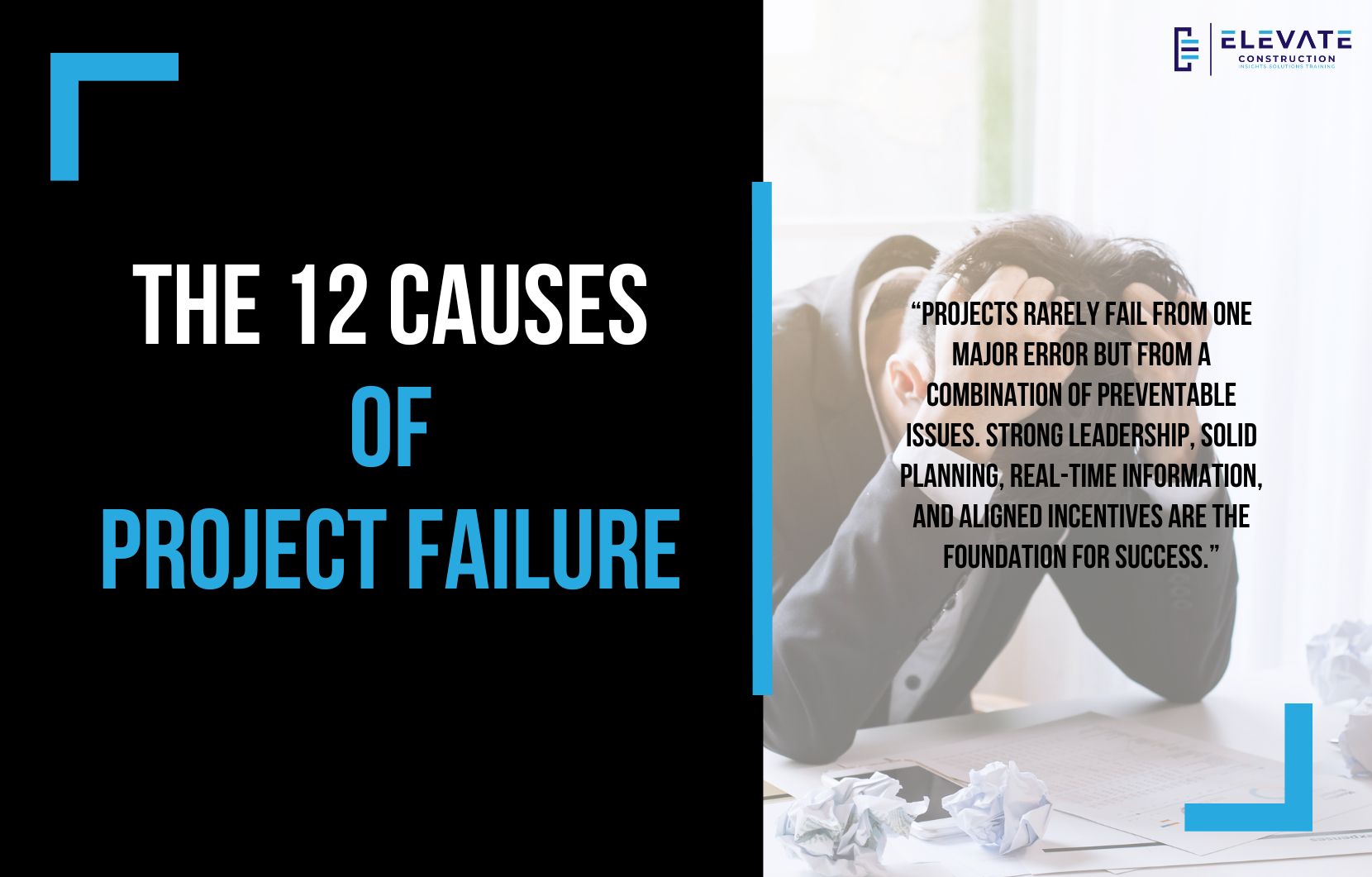The 12 Causes of Project Failure and How to Avoid Them
Construction projects often fail not because of one major misstep but due to a collection of preventable causes. Adam Beane has done an excellent job of outlining twelve key reasons projects stumble, and I want to share his insights while encouraging you to check out his work. These causes are not abstract theories. They show up every day on real projects, and the sooner we learn to address them, the more consistently we can deliver successful outcomes.
Before diving in, I want to share one of the builder’s codes that always applies: never yield ground. It is far easier to protect what you already have than to retake it once lost. In construction, this means guarding completed areas, maintaining stable operations, and producing quality work the first time. Rework is expensive, disruptive, and avoidable when we take this principle seriously. Protecting floors, cleaning spaces, posting clear signage, and setting strong expectations are practical ways to hold ground.
Now, let’s turn to the twelve causes of project failure identified by Adam Beane.
The first is lack of planning. Projects rarely go wrong halfway through; they start wrong. Without careful planning at the right ratio of effort, everything downstream suffers. In my own book, Elevating Preconstruction Planning, we emphasized this, and while an updated version is on its way, the message remains: planning is the foundation of success.
Second is poor leadership at the project manager or superintendent level. These two roles are critical in the United States and function like a two-person leadership team. If either is inexperienced, closed-minded, or unwilling to collaborate, the project falters. Owners know this, which is why they often ask who the leaders will be before awarding a job. Strong, open, capable leadership must come first.
Third are project changes, often in the form of scope creep or poor planning during design. Phased design packages and incomplete preconstruction efforts cause constant shifts during execution, destabilizing teams and eroding confidence. While design-build and CM at Risk have many strengths, they also carry risks of frequent design changes if not managed properly.
Fourth is poor scheduling. Traditional critical path method scheduling often sets teams up for failure. Modern approaches like takt planning, Last Planner, and Kanban provide the reliability and flow that complex projects demand. Without the right scheduling system, chaos is inevitable.
Fifth is the skill level of the team. Having the right people in the right seats is non-negotiable. On projects I have led, I deliberately stacked the deck with experienced, trained individuals I trusted. Teams succeed when competence and collaboration are built in from the start.
Sixth is management support. This comes in two forms: the organizational systems that provide scheduling, quality, and surveying tools, and the commitment from higher-level management—both within the contractor’s organization and the owner’s side—to support doing the right thing. Without this backing, teams fight uphill battles.
Seventh is funding. Underfunding projects leads to compromised planning, weakened general conditions, and reduced preconstruction effort. All of these combine to create a shaky foundation.
Eighth is cost containment. Staying within budget is about more than just subcontracts. It involves protecting contingencies and ensuring all codes and scopes remain financially stable throughout the project.
Ninth is resources. Projects require the right trades, equipment, and environmental support. Access to labor, power, communications, water, and drainage can all become make-or-break issues. Calling people resources diminishes their expertise, but without the right subject matter experts and tools, projects fail.
Tenth is information management. Construction thrives on real-time updates. Whether through Bluebeam, Procore, or other platforms, information must flow quickly, especially when design or financial approvals are in play. Lagging updates cause rework, frustration, and costly errors.
Eleventh is incentives. The way contracts and budgets are structured dictates behavior. Lump sum contracts may encourage hoarding, while toxic agreements create adversarial relationships. On the other hand, integrated agreements with aligned incentives encourage collaboration but can stall decision-making if not balanced correctly. Incentives drive behavior, and misaligned ones drive dysfunction.
Twelfth is the lack of continuous risk analysis. Speed and efficiency come not from pushing teams harder but from removing obstacles before they appear. Proactive risk identification keeps projects on track and prevents delays from compounding into crises.
These twelve causes outline why projects stumble and, more importantly, how leaders can prevent failure. They remind us that leadership, planning, resources, and trust are what make or break construction. By studying and applying these lessons, we can deliver projects that succeed more often, with fewer frustrations for everyone involved.
On we go.
Key Takeaway
Projects rarely fail from one major error but from a combination of preventable issues. Strong leadership, solid planning, real-time information, and aligned incentives are the foundation for success.
If you want to learn more we have:
-Takt Virtual Training: (Click here)
-Check out our YouTube channel for more info: (Click here)
-Listen to the Elevate Construction podcast: (Click here)
-Check out our training programs and certifications: (Click here)
-The Takt Book: (Click here)
Discover Jason’s Expertise:
Meet Jason Schroeder, the driving force behind Elevate Construction IST. As the company’s owner and principal consultant, he’s dedicated to taking construction to new heights. With a wealth of industry experience, he’s crafted the Field Engineer Boot Camp and Superintendent Boot Camp – intensive training programs engineered to cultivate top-tier leaders capable of steering their teams towards success. Jason’s vision? To expand his training initiatives across the nation, empowering construction firms to soar to unprecedented levels of excellence.
On we go

